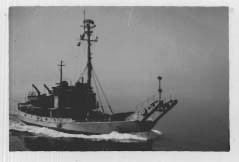
(AN-79: displacement 785 tons (full load); length 168'6"; beam 33'10"; draft 10'10"; speed 12 knots; complement 46; armament 1 3-inch gun, 6 20 millimeter machine guns; class Cohoes)
The monitor was apparently named for the Indian word meaning "white lily," while the district craft Etlah (AN-79) was named for the Civil War monitor.
__________
Etlah, a single-turret, light draft monitor, lay under construction at St. Louis, Mo., by Charles W. McCord (with turret to be constructed by James B. Eads) when the Navy ordered work on the ship suspended on 17 June 1865, after the close of the Civil War. Never in service, she was taken to Mound City, Ill., and laid up in 1867. Renamed Hecate on 15 June 1869, then back to Etlah on 10 August 1869, the vessel was taken to New Orleans, Louisiana, in 1872. Etlah lay at New Orleans until sold at public auction to Nathaniel McKay on 12 September 1874.
I
Etlah (AN-79) was laid down on 30 June 1944 at Portland, Ore., by Commercial Iron Works; launched on 16 December 1944; sponsored by Mrs. Phyllis I. Kane, the widow of the late Boatswain Francis D. Kane, who hailed from Portland, Ore., and who died in the sinking of carrier Wasp (CV-7) on 15 September 1942; and commissioned on 16 April 1945, Lieutenant Harry J. Stemler, Jr., D-V(G), USNR, in command.
From 8 June 1945 to 26 November, Etlah operated out of San Pedro, Calif., repairing and maintaining antisubmarine nets, and conducting salvage operations in the 11th Naval District. She then served at the Net Depot, Tiburon, Calif., testing experimental equipment and giving salvage service in the Oakland estuary.
In the spring of 1946, Etlah participated in Operation Crossroads, a combined military and civilian operation designed to test the effects of atomic weapons against ships carried out at Bikini Atoll in the Marshall Islands. The net tender arrived at Bikini on 1 April and joined Task Unit 1.2.7, the target vessel salvage unit of the larger Joint Task Force. Her crew placed buoys and towed target ships into position for test shot Able, a 23 kiloton airdrop test conducted on 1 July.
Following the detonation, Etlah placed boarding teams on eleven of the target vessels to conduct inspections and collect samples before commencing buoy and mooring operations on 7 July 1946 for the upcoming test Baker. Just over two weeks later, while engaged in mooring operations alongside target submarine Tuna (SS-203) on the 23d, a 10-ton anchor slipped off the submarine and crushed Etlah's ship launch. Luckily, no sailors were injured and the only loss was some equipment that went down in the lagoon with the sunken craft.
After test shot Baker, a much more destructive 23 kiloton underwater test conducted on 25 July 1946, Etlah again carried instrumentation teams to target ships as well as recovered underwater instrument arrays. In early August, the net tender recovered and repaired sunken buoys and raising fouled anchors in the lagoon. With target ship Mayrant (DD-402) in tow, she departed Bikini on 27 August in company with Current (ARS-22), arriving at Pearl Harbor via Kwajalein on 12 September.
Etlah was overhauled at Bremerton later that fall, and on 14 March 1947 was placed out of commission in reserve at Astoria, Oreg.
Following the outbreak of war on the Korean peninsula in 1950, and the ensuing mobilization of warships to support United Nations military operations there, the Navy also activated many service ships out of the Fleet Reserve depots. Etlah was recommissioned on 10 August 1951, Lt. Joseph K. Alexander in command, and after shakedown training, sailed for Japan, arriving 24 December.
The tender joined the host of other service ships at the burgeoning U.S. naval base at Yokosuka, maintaining the nets guarding Tokyo Bay and working on the nets at Pusan Harbor and Cheju, Korea. This yeoman work continued after the armistice in 1953, though Etlah added towing ships and targets off Japan and in the Philippines, launching and recovering radio-controlled drones in gunnery exercises, and serving as target ship for submarines and surface ships to her usual employment.
On 16 February 1960, Etlah sailed from Yokosuka for Pearl Harbor and San Diego, where she was decommissioned on 31 May 1960. The net tender was stricken from the Navy list on 1 July 1963 and subsequently transferred to the Maritime Administration Reserve Fleet. After more than a decade in reserve, ex-Etlah was sold to the Dominican Republic on 29 September 1976, where she served as patrol corvette Cambiaso (P-201) until hulked sometime in 1994.
Etlah received two battle stars for her Korean War service.
Minor corrections, 18 July 2007


